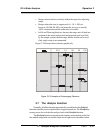
3 Operation Model 6600
3-22 Part I
Teledyne Analytical Instruments
Use the UP/DOWN switch to toggle between AUTO and MAN span
settling. Stop when MAN appears, blinking, on the display. Enter to move to
the next screen.
Span Val: 100 ppm
<ENT> To begin span
The unit field should be blinking first (%/ppm). Use the UP/DOWN switch
to set the proper unit of the span fluid and enter. Then, use the UP/DOWN
switch to set the concentration.
When you have set the concentration of the span fluid you are using, Enter
to begin the Span calibration.
Once the span has begun, the microprocessor samples the output at a
predetermined rate. It calculates the difference between successive samplings
and displays this difference as Slope on the screen. It takes several seconds for
the first Slope value to display. Slope indicates rate of change of the Span
reading. It is a sensitive indicator of stability.
####.## ppm OIL
Slope=#.### Span
When the Span value displayed on the screen is sufficiently stable, Enter.
(Generally, when the Span reading changes by 1 % or less of the range being
calibrated for a period of 30 seconds it is sufficiently stable.) Once the span
ends, the calibration is stored in memory. The instrument then automatically
enters the Analyze function.
3.5 The Alarms Function
The Model 6600 is equipped with 2 fully adjustable set points concentra-
tion with two alarms and a system failure alarm relay. Each alarm relay has a set
of form “C" contacts rated for 3 amperes resistive load at 250 V ac. See Figure
in Chapter 2, Installation and/or the Interconnection Diagram included at the
back of this manual for relay terminal connections.
The system failure alarm has a fixed configuration described in chapter 2
Installation.
The concentration alarms can be configured from the front panel as either
high or low alarms by the operator. The alarm modes can be set as latching or
non-latching, and either failsafe or non-failsafe, or, they can be defeated
altogether. The setpoints for the alarms are also established using this function.
Decide how your alarms should be configured. The choice will depend
upon your process. Consider the following four points:


















